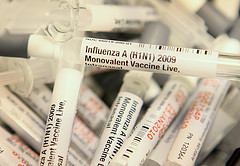
The H1N1 flu vaccine is starting to be available at clinics, hospitals, and doctor's offices around the country. With the pandemic flu in full swing, many people are asking whether they should get the vaccine. The concerns are especially acute because several versions of the injectable vaccine contain the mercury preservative thimerosal. California this week temporarily suspended its ban on thimerosal in vaccines to allow distribution of the H1N1 vaccine.
Thimerosal contains an organic form of mercury called ethyl mercury. Some people have claimed that the historical use of thimerosal in vaccines was responsible for the autism epidemic, and other people just worry because mercury is a neurotoxin. So what should people do? Is this vaccine recommended for pregnant women and kids?
In my view, the answer is definitely yes. Despite the thimerosal.
According to the package insert, a multi-dose vial of the H1N1 flu vaccine contains about 25 micrograms of mercury per dose. In comparison, an average can of albacore tuna contains about 60 micrograms of mercury. So the vaccine offers a dose of mercury that is less than that in 1/2 can of tunafish. At the same time, the vaccine protects against a disease that at best results in several days of discomfort and missed school or work, and at worst results in serious complications and even death. Seems like a worthwhile trade-off.
I was a strong advocate for the removal of mercury from vaccines. In most cases it's unnecessary, since single-dose vaccines don't need a preservative. Also, there were valid concerns about the cumulative mercury dose that young children receive from all of their vaccinations. The scientific studies looking at the autism-thimerosal connection have convincingly shown no link, but that doesn't negate the extensive science on methyl mercury (the organic form of mercury found in fish) which has been clearly shown to cause neurological delay after prenatal exposure.
So why make an exception for thimerosal in the H1N1 vaccine? This vaccine needed to be developed and distributed very quickly, since this pandemic flu emerged recently and is spreading fast. Multi-dose vials are more efficient to produce, but they require a preservative. It's essentially a trade-off for speed. If the thimerosal were really worrisome at this level, the trade-off might not be worth it, but in my opinion it is. For those people who are really worried about thimerosal, there will be some preservative-free vaccine distributed, and there's the FluMist (for those who can take it). But not everyone can take FluMist, and waiting for the preservative-free vaccine means being unprotected for longer - you take your chances with this flu.
The CDC recommends that the following groups get vaccinated: pregnant women, household contacts and caregivers for children under 6 months of age, healthcare personnel, children and young adults up through age 24, and people aged 25-64 with certain health conditions. As a health care provider, I'm in a group that should get the vaccine in order to protect my patients, so I'm on my way over to get it. Maybe I'll skip the tunafish sandwich today for lunch.
* * * This post originally appeared on NRDC's Switchboard.
Gina Solomon is Senior Scientist at The Natural Resources Defense Council in San Francisco. For the past 12 years at NRDC she has focused on protecting people from toxic chemicals. She has been worked on preventing mercury and lead poisoning, researching levels of diesel exhaust inside school buses, working to ban the most dangerous pesticides, getting endocrine disrupting chemicals out of consumer products, and helping to answer people's questions about their health and the environment. She attended medical school at Yale University and did a residency in Internal Medicine, followed by a Fellowship in Occupational and Environmental Medicine at Harvard. In recent times, she has become increasingly concerned about health threats from global warming. NRDC is a non-profit organization dedicated to protecting the environment, people and animals. NRDC was founded in 1970 and is comprised of more than 300 lawyers, scientists and policy experts, with more than one million members and e-activists.

